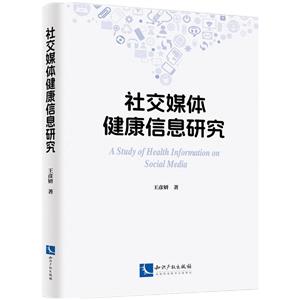-
>
蜜蜂的寓言:私人的惡德,公眾的利益
-
>
世界貿易戰簡史
-
>
日本的凱恩斯:高橋是清傳:從足輕到藏相
-
>
近代天津工業與企業制度
-
>
貨幣之語
-
>
眉山金融論劍
-
>
圖解資本論
社交媒體健康信息研究 版權信息
- ISBN:9787513092142
- 條形碼:9787513092142 ; 978-7-5130-9214-2
- 裝幀:平裝-膠訂
- 冊數:暫無
- 重量:暫無
- 所屬分類:>>
社交媒體健康信息研究 本書特色
圍繞社交平臺研究健康信息相關的傳播特點,對于數字時代信息挖掘具有一定借鑒。
社交媒體健康信息研究 內容簡介
信息的增長、術語定義和概念內涵的變化為信息搜索和使用帶來了困難;新技術的普及使用戶在網絡上的信息行為變得更為復雜。在大量網絡信息中,健康信息是重要的一部分,社交媒體也成為用戶生產、傳播、使用健康信息的重要平臺。本書對社交媒體健康信息的相關概念、研究對象和內容、研究成果進行了較為全面的梳理,總結了社交媒體健康信息研究的主要方法、技術,并以維基百科家庭健康信息研究作為實例,呈現了此類研究的完整過程。
社交媒體健康信息研究 目錄
1.1 Introduction 001
1.2 Notions 002
1.2.1 Social Media 002
1.2.2 Data, Information, Knowledge & Knowledge Production 003
1.2.3 Lay People VS Experts 005
1.3 Knowledge Production: Past & Present 006
1.3.1 Development of Knowledge Production: Past& Present 006
1.3.2 What is Commons-based Peer Production 007
1.3.3 What is Produsage 008
1.3.4 Features of Social Media Knowledge Production 009
1.3.5 Comparison of Past and Present Knowledge Production 014
1.4 Participation of Lay People 016
1.4.1 Lay People Foster Data, Information and Knowledge Production 017
1.4.2 Lay People Complicate Data, Information and Knowledge Production 021
1.5 Quality Control of Content on Social Media 024
1.5.1 Quality Control Approaches 024
1.5.2 Role of Experts 028
1.6 Summary 030
Chapter 2 Research Methods Applied in Studies on Social Media 032
2.1 Introduction 032
2.2 Data Collection Methods 033
2.2.1 Data Types 033
2.2.2 Data Collection Approaches 035
2.2.3 Data Integration 038
2.3 Data Analysis Approaches 040
2.3.1 Social Web Mining 040
2.3.2 Coding of Social Media Content 044
2.4 Challenges of Social Media Research: Data Collection and Analysis 045
2.4.1 Challenges in Data Collection 045
2.4.2 Challenges in Data Analysis 047
2.5 Summary 048
Chapter 3 A Study of Health-Related Information on Social Media:Evolution of Family-Health-Related Topics 050
3.1 Background & Rationale 050
3.2 Research Problem, Questions and Hypotheses 052
3.2.1 Research Problem Statement 052
3.2.2 Research Question 1 053
3.2.3 Research Question 2 054
3.2.4 Research Question 3 056
3.3 Research Design 057
3.4 Definitions of Terms 058
3.5 Health Information Studies 061
3.5.1 Consumer Health Information 062
3.5.2 Health Information on Social Media 063
3.5.3 Family Health Studies 064
3.6 Temporal Analysis 067
3.6.1 What is Temporal Analysis 068
3.6.2 Temporal Analysis Applied to Information Retrieval 070
3.6.3 Temporal Analysis Applied to Data Mining 076
3.7 SOM Studies 082
3.7.1 SOM History, Theories and Algorithms 082
3.7.2 Applications of SOM 083
3.8 Summary 085
Chapter 4 Evolution of Family-Health-Related Topics on SocialMedia: Methodology 086
4.1 Introduction 086
4.2 Assumptions 087
4.3 Data Collection 089
4.3.1 Selection of a Social Media Platform 089
4.3.2 Selection of Topics 090
4.3.3 Selection of Entries 092
4.3.4 Selection of the Periods 093
4.3.5 Text Collection 094
4.3.6 Page Views and Edits Data Collection 096
4.3.7 Ethic Issues 096
4.4 Data Analysis 097
4.4.1 Categories and Themes 097
4.4.2 Text Data Organization 098
4.4.3 SOM Approach 099
4.4.4 Subject Analysis 101
4.4.5 Inferential Analysis 103
4.4.6 Temporal Analysis 104
4.5 Validity and Reliability 104
4.5.1 Validity 104
4.5.2 Reliability 105
4.6 Summary 106
Chapter 5 Evolution of Family-Health-Related Topics on SocialMedia: Results 108
5.1 Descriptive Results 108
5.1.1 Topics and Themes 108
5.1.2 Descriptive Results of Page Edits 111
5.1.3 Descriptive Results of Page Views 114
5.1.4 Descriptive Results Summary 117
5.2 Results of Research Question 1 118
5.2.1 Topics, Themes, and Associated Entries 118
5.2.2 Subjects Analysis Results 119
5.2.3 Research Question 1 Results Summary 135
5.3 Results of Research Question 2 137
5.3.1 Entry Growth in Each Period 137
5.3.2 Changes in Subjects 139
5.3.3 Changes in External Popularities 150
5.3.4 Research Question 2 Results Summary 154
5.4 Results of Research Question 3 156
5.4.1 Differences and Commonalities among the External Popularity Evolution Patterns 156
5.4.2 Differences and Commonalities among the Internal Characteristic Evolution Patterns 158
5.4.3 Research Question 3 Results Summary 160
5.5 Summary 160
Chapter 6 Evolution of Family-Health-Related Topics on SocialMedia: Discussion, Implications, and Conclusion 162
6.1 Discussion 162
6.1.1 External Popularity Evolution Patterns 162
6.1.2 Internal Characteristic Evolution Patterns 167
6.1.3 Internal Characteristics VS External Popularities 169
6.1.4 Wikipedia VS Other Platforms 170
6.1.5 Discussion Summary 172
6.2 Implications 172
6.2.1 Theoretical Implications 173
6.2.2 Practical Implications 176
6.2.3 Methodological Implications 179
6.2.4 Implication Summary 181
6.3 Conclusion 181
6.3.1 Research Problem and Primary Findings 181
6.3.2 Findings of Family Planning 182
6.3.3 Findings of Women’s Health 183
6.3.4 Internal Characteristic and External Popularity Evolution Patterns 183
6.4 Limitations 184
6.5 Future Directions 185
References 186
Appendix A Topics, Themes and Associated Entries 218
Appendix B High-Frequency Terms and Phrases in Each Theme 221
Appendix C Entries in Each Theme during Each Period 222
Appendix D Entries Created in Each Theme during Each Period 224
社交媒體健康信息研究 作者簡介
王彥妍,美國威斯康辛大學密爾沃基分校情報學博士,中國人民大學信息資源管理學院講師,人文北京研究中心、中國人民大學數字人文研究中心、中國人民大學信息資源管理學院CIO研究中心研究員,國際標準化組織IEC SyC Smart Cities/WG1注冊專家。主要研究方向為:信息檢索,用戶行為,健康信息,數字人文等。公開發表學術論文十余篇,在高水平國際會議上發言9次。獨立主持國家社會科學基金研究項目1項,中國人民大學校級科研項目1項,參與國家社會科學基金研究項目1項、中國人民大學年度項目3項。
- >
月亮虎
- >
朝聞道
- >
史學評論
- >
名家帶你讀魯迅:故事新編
- >
新文學天穹兩巨星--魯迅與胡適/紅燭學術叢書(紅燭學術叢書)
- >
煙與鏡
- >
羅庸西南聯大授課錄
- >
山海經

















